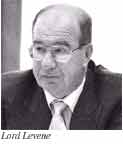The NAPSLO Annual Convention took place Sept. 10-14 in San Diego at the San Diego Marriott Hotel & Marina. For more Insurance Journal interviews and special video coverage of the NAPSLO Convention, including an exclusive interview with Lloyd’s of London chairman Lord Levene, visit our Web site at https://www.insurancejournal.com/ interviews/napslo/annual/.
Regulatory Principles Adopted
The NAPSLO Board adopted a set of nine Regulatory Principles aimed at guiding the Association in its response to legislative/regulatory issues affecting the E&S industry at both the state and federal level.
In its set of principles the Board supported a system of state based regulation, freedom of rate and form for E&S policies and standardization of taxation of multi-state surplus lines risks.
The principles were developed to advise the NAPSLO membership and the industry of the NAPSLO Board’s positions on major regulatory issues impacting the industry and to provide its Legislative Committee and future Boards with a roadmap regarding Association’s positions on regulatory issues.
“We believed it was important to outline our beliefs,” president Nick Cortezi said. “On several issues, such as freedom of rate and form regulation, our position had always been very clear and well-known. On other issues we had developed positions but they may not have been very well known among our members and the industry. The set of regulatory principles allows our board, committees, membership, and also the industry to know our positions on important regulatory issues.”
The following outlines the positions as adopted in the regulatory principles:
I. Freedom From Regulation of Surplus Lines Rates and Forms
II. The Principle of Export – surplus lines transactions involve state regulated surplus lines brokers exporting business to non-admitted companies not regulated by the state.
III. Primacy of Surplus Lines – state based residual market mechanisms should not be given risk placement preference before surplus lines.
IV. Uniform and Reciprocal Licensing of Surplus Lines Brokers Between the States – NAPSLO’s goal is a uniform and reciprocal 50 state system.
V. Standardization of Taxation of Multi-State Surplus Lines Risks – NAPSLO’s goal is a simple and conflict free single payment system for remitting surplus lines taxes on multi-state risks.
VI. Guaranty Funds – NAPSLO is opposed because they promote a false security; they promote the use of financially weak companies; there is a potential premium assessments which is an unfair burden on surplus lines consumers; the surplus lines marketplace is financially secure and dominated by companies with average ratings significantly higher than the overall market.
VII. Commercial Lines Deregulation – Automatic Export – Transactions involving exempt commercial policyholders under state commercial lines deregulation laws should automatically qualify for export to the surplus lines market without conducting a diligent search.
VIII. State Regulation – NAPSLO favors the continuation of a state-based regulatory system for insurance over a federal system. However, the current state-based system must become more uniform and efficient. Any federal regulation should include the uniformity and reciprocity among and between the states in the areas of producer licensing and taxation are desirable.
 |
Lloyd’s Levene on Surplus Lines
The surplus lines insurance market will become increasingly important to the U.S. economy, Lord Levene, chairman of the global insurance market Lloyd’s of London, predicted.
Speaking at the Convention, Lord Levene set out a vision of how the surplus lines market was likely to develop over the next 20 years.
He said that growth in the surplus lines sector had been disproportionate to the insurance industry and the economy over the last two decades. In 1981, the surplus lines industry represented 3.9 percent of the total U.S. commercial lines market, but this had increased to 8.4 percent by 2001.1
Commenting on these figures, he said: “That’s a powerful trend—one which is likely to continue as the commercial environment becomes ever more complex and appetite for risk in the admitted market reduces. And it means that surplus lines could account for over 15 percent of the U.S. market in 20 years time, double what it is today.”
Lord Levene went on to say that national barriers will cease to have significance, as the U.S. and global insurance markets become ever more interdependent. “In 20 year’s time, distinctions between the U.S., London, Europe, Bermuda and growing Asian markets will become blurred as the industry finally gets to grips with technology and capital becomes truly mobile,” he said.
Finally, Levene outlined the need to educate and lobby the wider marketplace about the surplus lines industry. This would improve consumer understanding of surplus lines as a financially secure, well regulated market and help ensure that any future legislative and regulatory developments acknowledge and reflect the role and importance of the surplus lines sector.
Lord Levene also emphasized that Lloyd’s was a global insurance market, and had a continuing commitment to the surplus lines industry and a key role at the heart of the U.S. insurance industry.
1 AM Best, Annual Review of the Excess & Surplus Lines Industry, September 2002.
H. James Griffith Elected President
H. James Griffith of Princeton Risk Managers Inc., Princeton, New Jersey was elected as the new president of NAPSLO.
NAPSLO member firms voted on the proposed slate of Officers and Directors during the Annual Business Meeting, on Sept. 13.
Jim Griffith is president of Princeton Risk Managers, which he founded in 1974, and is a U.S. Correspondent at Lloyd’s of London. He has served as Chairman of the IIANJ State Legislative Committee, the New Jersey Surplus Lines Association Legislative Committee, and the State of New Jersey Commission to Study Commercial Insurance Deregulation. He has also served on the IIABA Federal Affairs Committee.
Griffith was elected to the NAPSLO Board in 1997 and was elected an officer in 2000. He has also served as president of the New Jersey Surplus Lines Association. He attended Rutgers University and the Wharton School (Risk Management), and has been an instructor for the Society for Certified Insurance Counselors.
The following individuals were elected as new NAPSLO officers:
President – H. James Griffith, president, Princeton Risk Managers Inc., Princeton, New Jersey.
Vice president – Richard L. Polizzi, president & CEO, Western Security Surplus Insurance Brokers Inc., Pasadena, California.
Secretary – Lawrence M. Wesson, Jr., president and COO, U.S. Risk Insurance Group, Dallas.
Treasurer – William H. Newton, president and owner, Lemac & Associates, Los Angeles.
 |
 |
 |
 |
Nominated for a new three-year term on the NAPSLO Board was Dale H. Pilkington of Colony Insurance Company, Richmond, Va.
Re-nominated for new three-year terms on the NAPSLO board are: Griffith, Wesson, G. Stephen Allen, CRC Insurance Services Inc., Raleigh, N.C.; and Patricia H. Roberts, General Star Indemnity Company, Stamford, Conn.
Directors are nominated for three-year terms on the Board. Officers are nominated for a one-year term.
Topics USA Agencies Legislation Excess Surplus New Jersey Market Lloyd's London Risk Management
Was this article valuable?
Here are more articles you may enjoy.


 Hacker Says AT&T Paid About $400,000 to Erase Sensitive Data
Hacker Says AT&T Paid About $400,000 to Erase Sensitive Data  Man Admits to Tracking Drivers, Programming Keys, Stealing and Reselling Vehicles
Man Admits to Tracking Drivers, Programming Keys, Stealing and Reselling Vehicles  The Battle Over J&J’s Bankruptcy Plan to End Talc Lawsuits
The Battle Over J&J’s Bankruptcy Plan to End Talc Lawsuits  Project 2025 Plan to End NFIP Welcomed by Some, Rejected by Others in Insurance
Project 2025 Plan to End NFIP Welcomed by Some, Rejected by Others in Insurance 


